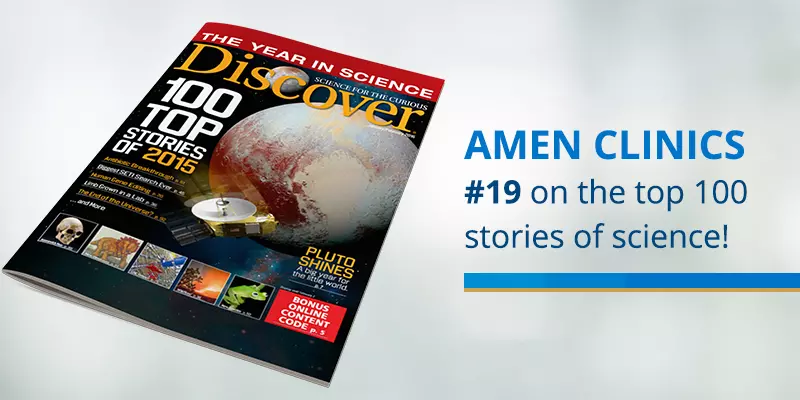
We are so excited that the pioneering research at Amen Clinics was just highlighted in Discover Magazine as number 19 of the top 100 stories in all of science for 2015! Our research was sandwiched between Tesla’s new entry into renewable energy at #18 and the discovery of a new dinosaur species at #20.
The research team at Amen Clinics, in collaboration with scientists from UCLA, Thomas Jefferson University, and the University of British Columbia, published the world’s largest functional brain imaging study on more than 21,000 patients that demonstrated we can distinguish between posttraumatic stress disorder (PTSD) and traumatic brain injury (TBI) using brain SPECT imaging with high accuracy. Our study was published in the prestigious journal, PLOS ONE in July 2015.
With SPECT, We Can See the Difference
SPECT (single photon emission computed tomography) is the type of advanced brain imaging we use at Amen Clinics. It allows us to do an overall evaluation of a person’s brain function and identify areas of the brain that are normal, as well as areas that are overactive or underactive. This capability is particularly important when trying to differentiate between PTSD and TBI, because these two conditions have several overlapping symptoms, including:
- Irritability and/or anger
- Insomnia or other sleep problems
- Symptoms of depression
- Heightened or excessive anxiety
- Social isolation
- Impulse control problems
- Difficulty with concentration
However, even though some of the symptoms are the same, PTSD and TBI present with very different patterns on SPECT images. Most commonly, PTSD reveals areas of overactivity, while TBI has areas of decreased activity in the brain. Our study found that with brain SPECT imaging, we were able to distinguish PTSD from TBI with 80% – 100% accuracy.
Using SPECT to Guide Treatment
The ability to differentiate these disorders from each other is critical for determining the most effective treatment for each individual. Without knowing the underlying biological issue, it is easy to mistake one condition from the other – and the problem is that the treatments for each are very different.
Typically, treatment for PTSD and emotional trauma is psychological in nature and the goal is to try to calm down the brain. Conversely, treatment for TBI is more physiological in nature and focuses on increasing activity in the injured areas of the brain. So, for example, if a doctor diagnoses someone with PTSD (but it’s really TBI), a sedating medication might be prescribed. Unfortunately this is not what someone with a TBI needs because the activity in the brain is already suppressed as a result of the injury, thus this type of treatment will not likely be of any help and may actually cause further harm.
Why This Study is So Important Now
There are approximately 1.7 million emergency room visits in the U.S. each year for head trauma along with hundreds of thousands of undiagnosed concussions primarily from sports, recreational accidents and falls. It is also estimated that 1 out of 30 adults in the U.S. has PTSD. When we add the numbers of impacted veterans to this— more than 300,000 have been diagnosed with TBI and 125,000 with PTSD—these conditions are significant health problems.
By using SPECT to help differentiate between PTSD and TBI, it is our hope that the findings from our study and the acknowledgement by Discover Magazine will help millions of people suffering with one or both of these devastating conditions to be correctly diagnosed. By being able to identify the underlying brain problem, people are given the best possible opportunity to receive the correct diagnosis and treatment so they can feel better and have more healthy and productive lives.
If you know people who suffer from PTSD or TBI, referring them one of our clinics may be very helpful in their care.






Dear Dr. Amen,
I am so impressed and excited about your work. I had the utmost pleasure to see your brain scans of psychic medium, Theresa Caputo on the Dr. Oz show. As a soul reader, (having performed over 1,400 readings since going public with my abilities, Jan. 2014, reading souls of the living), and as a Source communicator, (I allow the being I call God to speak through me, on stage, in Source Talks around the country), and as a Godscribe, (Universal Consciousness first began speaking to me, whiles still an atheist, through my notebook), I would love a way to document my brain patterns, while performing this unique facility, which I mastered over a 10 year period, before going public. If you’re still doing research in this area, I would love to be considered for any brain mapping experiments you may be conducting. — Thank you so much for doing this work incredibly important work! I believe my work would make for a great conversation in the areas you are most competent in studying. Warmest regards, Sondra Sneed
Comment by Sondra Sneed — April 17, 2017 @ 4:41 PM